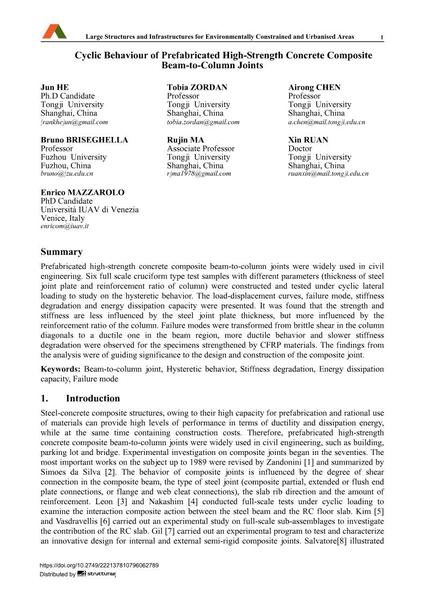Cyclic Behaviour of Prefabricated High-Strength Concrete Composite Beam-to-Column Joints

|
|
|||||||||||
Bibliographic Details
| Author(s): |
Jun He
Tobia Zordan Airong Chen Bruno Briseghella Rujin Ma Xin Ruan Enrico Mazzarolo |
||||
|---|---|---|---|---|---|
| Medium: | conference paper | ||||
| Language(s): | English | ||||
| Conference: | IABSE Symposium: Large Structures and Infrastructures for Environmentally Constrained and Urbanised Areas, Venice, Italy, 22-24 September 2010 | ||||
| Published in: | IABSE Symposium Venice 2010 | ||||
|
|||||
| Page(s): | 586-587 | ||||
| Total no. of pages: | 9 | ||||
| Year: | 2010 | ||||
| DOI: | 10.2749/222137810796062789 | ||||
| Abstract: |
Prefabricated high-strength concrete composite beam-to-column joints were widely used in civil engineering. Six full scale cruciform type test samples with different parameters (thickness of steel joint plate and reinforcement ratio of column) were constructed and tested under cyclic lateral loading to study on the hysteretic behavior. The load-displacement curves, failure mode, stiffness degradation and energy dissipation capacity were presented. It was found that the strength and stiffness are less influenced by the steel joint plate thickness, but more influenced by the reinforcement ratio of the column. Failure modes were transformed from brittle shear in the column diagonals to a ductile one in the beam region, more ductile behavior and slower stiffness degradation were observed for the specimens strengthened by CFRP materials. The findings from the analysis were of guiding significance to the design and construction of the composite joint. |
||||
| Keywords: |
hysteretic behavior failure mode stiffness degradation energy dissipation capacity Beam-to-column joint
|
||||
